- Home
- Encyclopedia
- Peace, War, Land and a Funeral: The Fort Larami...
Peace, War, Land and a Funeral: The Fort Laramie Treaty of 1868
Toward sunset one evening in March 1866, a large group of Indian, white and mixed-blood people moved away from the parade ground at Fort Laramie and out toward a graveyard on a hill. Leading them was an army wagon with a coffin in it. Next came a small group of relatives of the dead girl. Their clothes, a feather or two, and the fur around the edges of their buffalo robes fluttered slightly in the breeze. Next came a large crowd of officers, enlisted soldiers, and tribespeople, walking quietly and paying attention to the weather and their steps. Slowly they made their way over the ground past the sutler’s store and hospital, and up a low rise beyond.
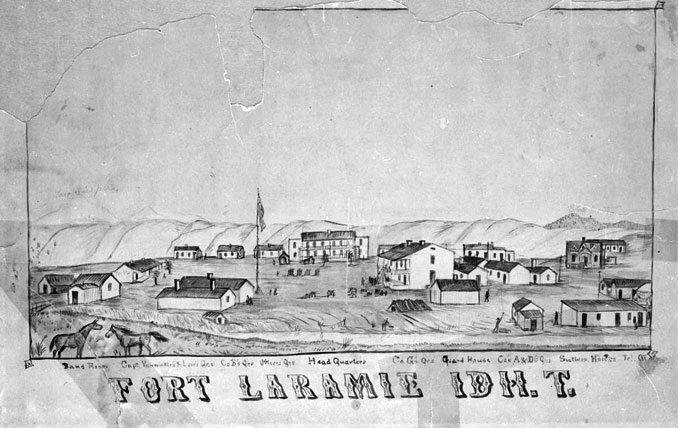
At the cemetery was a platform on four posts about seven feet high. The relatives of the dead girl gathered closest around the coffin: her mother, her aunts, and her father, Spotted Tail or Sinte Gleska, chief of the Brulé or Sicangu Lakota, called Sioux by the whites. The other Indians and soldiers stood in rings around the relatives.
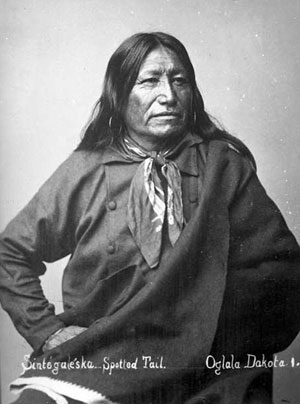
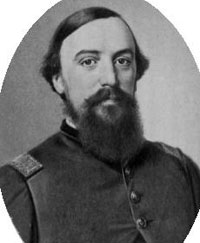
|
Then in the silence a chaplain gave a prayer, which an interpreter translated into Lakota. The dead girl’s mother and aunts wept quietly. Other people placed special things on the coffin. Col. Henry Maynadier, the highest-ranking soldier at the fort, laid down his best kid gloves. Then the girl’s relatives covered the coffin with a buffalo robe and a red wool blanket, raised it to the platform, and tied it down with leather thongs.
By 1866 war between Indians and whites had become almost constant on the high plains of what soon would become Wyoming. An event like this was rare. Old-timers regarded it as “unprecedented,” Col. Maynadier reported to officials back in Washington, D.C. But he had high hopes, he added, that the mutual feelings of loss would allow both sides to come together in “a certain and lasting peace.”
Young Mni Akuwin
Spotted Tail’s daughter Mni Akuwin—Brings Water Home—was born about 1848, so she would have been 17 or 18 when she died. Probably she was with her people when trouble broke out in their village in 1854, and 2nd Lt. John Grattan and his 30 soldiers were killed, and with her people also when they were attacked in turn by Brig. Gen. William Harney’s cavalry on Blue Water Creek in western Nebraska the following year. Many children and women were killed in that fight, and many more were taken back to Fort Laramie by the soldiers, as hostages.
When her father went to prison at Fort Leavenworth in distant northeastern Kansas the year after that, his family went with him. On their way home, after he was released, they spent some months at Fort Kearny in Nebraska. And each year after that, when Spotted Tail and the Brulé people visited Fort Laramie to trade and to pick up the food and clothes the government had promised them, Mni Akuwin went along.
She became a particular friend of the officers and their wives—“they made a pet of her,” one historian put it. She loved to watch soldiers march and turn and slap their rifles to the ground. And they liked showing off for her. “Among ourselves we called her ‘the princess,’” an officer remembered many years later. “She was looking, always looking, as if she were feeding upon what she saw.”
Years of war
Relations worsened between whites and Indians as tens of thousands of people poured each year past Fort Laramie on the Oregon/California/Mormon Trail. The Brulé people stayed more friendly than other Lakota bands did—the Oglala and the Hunkpapa, for example. But after the massacre of a peaceful Cheyenne village on Sand Creek in Colorado near the end of 1864, even the Brulé felt they had to make war. That winter, the southern Cheyenne, Arapaho, and various Lakota bands all moved north, raiding as they went. On the Powder and Tongue Rivers in northern Wyoming, they joined up with the Oglala, in gatherings of great power.
The following summer was all-out war. Lt. Caspar Collins and 26 other soldiers were killed in a fight at what’s now Casper, Wyo. General Patrick Connor led a successful attack on an Arapaho village on the Tongue River, but his 2,500 troops came close to starving later that summer as they chased the tribes all over the Powder River country. From Fort Laramie, Col. Thomas Moonlight sent Spotted Tail and the Brulé under guard down the Platte to Fort Kearny, as prisoners of war. But they escaped, crossed the river, and headed north. When the cavalry came after them the Indians ran off all the soldiers’ horses, and they had to walk 100 miles back to Fort Laramie in disgrace, carrying their saddles.
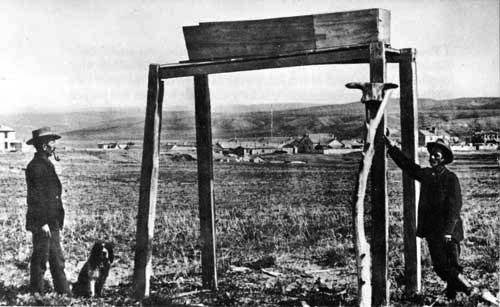
The whites realized they were getting nowhere, and decided to see if they could make peace. In the fall, Col. Maynadier sent messages out to the Oglala and Brulé bands in the Powder River country. After three months the messengers returned: Red Cloud and 250 Oglala lodges would come the fort to talk, also Swift Bear, Spotted Tail, and the Brulé people. Despite their victories, it had been a hard winter. Buffalo were harder than ever to find, and when the generally peaceful tribes like the Brulé made war, they had to do without the yearly supplies the government owed them otherwise.
Just as the Brulé were starting on the long trip south to Fort Laramie, Mni Akuwin died, probably of tuberculosis or pneumonia, perhaps of simple hunger and exhaustion. She had never done well away from the forts. Before she died she asked her father to have her buried near the fort. Spotted Tail sent a message to Maynadier asking if this would be possible. Maynadier immediately answered yes.
The colonel had known the family years before, perhaps when he spent the winter on Deer Creek near what’s now Glenrock, Wyo., with an army expedition mapping parts of what are now Wyoming and Montana drained by the Yellowstone River. But up to this point Maynadier had been unsure of Spotted Tail’s real intentions—whether peaceful or warlike. Now he was sure the chief meant peace. He rode out with a small group of officers to welcome the Brulé when he learned they were near.
Back at the fort, Maynadier told Spotted Tail that a special commission of peacemakers would arrive from the East in a few months to work out details of a treaty. Meanwhile, he was honored that the chief would trust him with his daughter’s remains, and they should have a funeral at sunset.
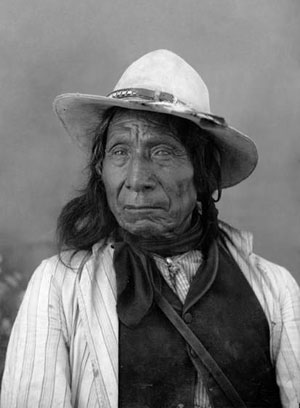
Spotted Tail was moved, yet calmed by the colonel’s sympathy. He said the tribes were due payments to make up for the vanishing buffalo, and all the new roads being built through their lands. But such matters could wait for later, he said, when the peace commissioners came. The chief’s emotions had a strong effect on the other Indians, Maynadier reported, “and satisfied some [whites] who had never before seemed to believe it, that an Indian had a human heart to work on and was not a wild animal.”
An attempt at peace
Within a few days, Red Cloud and 200 Oglala warriors arrived. As weeks went by, more and more Indians camped nearby, coming and going all the time. The soldiers were nervous, especially when the Indian men walked around with their bows strung and their hands full of arrows. The soldiers didn’t trust their officers, either. Private Hervey Johnson wrote home to his sisters in Ohio that Maynadier had been making nothing but promises to the Indians all spring, “the most of which he is unable to fulfil, and in fact being drunk most of his time I guess he don’t know half the time what he is promising.”
Johnson was right. Maynadier was making a lot of promises, and giving out a lot of presents and supplies so the tribes would stick around. This was risky. Though it was clear the grieving Spotted Tail was for peace, neither Maynadier nor any of the white officers had bothered to find out what Red Cloud and the Oglalas thought.
At last the peace commissioners arrived. The government had no desire, they told the Indians, to buy or occupy their land. All they wanted was a safe way through the Powder River country. Gold had been discovered in Montana, and much of the fighting had been along the Bozeman Road, the new road north to the gold fields. Whites would stay on the roads and wouldn’t kill off the buffalo or otherwise disturb the game, the commissioners promised. If the tribes would agree, they would be paid well in yearly supplies. Red Cloud and Spotted Tail asked for time to bring in the rest of their people, camped in Nebraska, a few days’ journey away.
The day the peace talks reopened, by sheer coincidence, Col. Henry B. Carrington and 700 troops showed up at Fort Laramie. They were on their way to build new forts on the Bozeman Road. No one had told the Indians about this. Red Cloud was disgusted. Here the Indians had agreed to nothing, and yet the whites were sending a new army to build new forts in the country they still had no rights to travel through. With the other fighting Indians, mostly Oglala, he left and went back north.
Spotted Tail, the Brulé people and some southern Oglala people signed the treaty. They were tired of war, tired of living away from the big forts, and they had never really regarded the Powder River country as theirs in any case. The commissioners had signatures on paper, but their loose promises and the army’s bad timing only ensured more war.
More war
It came to be called Red Cloud’s War. Carrington’s troops strengthened Fort Reno on the Powder and built two more forts—Fort Fort Phil Kearny on Piney Creek near what’s now Story, Wyo., and Fort C.F. Smith on the Bighorn River in Montana Territory. The tribes raided the road constantly, making travel almost impossible. In December, Red Cloud’s Oglala warriors and their Cheyenne allies lured Captain William Fetterman and 80 soldiers out of Fort Phil Kearny and killed them all in the snow. Two more fights near the forts the following summer ended in a draw.
Again, the government was ready to try peace. But this time, the Union Pacific Railroad was being built across the plains, changing everything. After the Indians made just a few raids on the railroad route, company officials had threatened to stop work altogether unless the government could protect the crews.
Congress appointed a new peace commission in 1867. These men met first with leaders of the southern plains tribes in Kansas—Cheyenne, Arapaho, Kiowa, Comanche and Apache. The leaders agreed their people would move onto reservations. But the people didn’t like the idea much, and soon rejected it. At Fort Laramie, no Lakota people would come in to talk at all. Red Cloud sent word that the war would stop as soon as the army abandoned the new forts and closed the Bozeman Road.
Peace again on the horizon
And this, the government was ready to do. For one thing, the army had shrunk drastically since the end of the Civil War. There simply weren’t enough troops to protect the Bozeman Road, the railroad builders and the new black citizens and their right to vote in the Reconstruction South.
Second, war was expensive. Congressmen who favored peace argued it was cheaper to feed the Indians than to fight them. Third, it was unjust. Ever since Sand Creek, Congress and the nation had been rethinking the fairness of making war on Indians to force them to give up their lands.
Finally, as soon as the new railroad was finished, there would be a much shorter wagon route north from Utah to the gold fields of western Montana. Whites would not need the Bozeman Road anymore. It wasn’t worth more war.
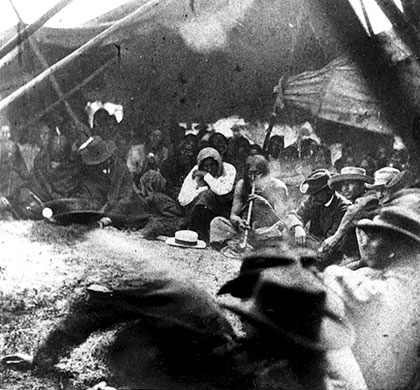
Gen. Ulysses S. Grant sent word to abandon the forts on the Bozeman Road. The peace commission took the train to Cheyenne in early April 1868, and from there took the road to Fort Laramie. With them they brought Spotted Tail and his headmen from Nebraska, and a load of presents for any Indians willing to sign a new treaty.
A new treaty, an uncertain future
The Treaty of Fort Laramie of 1868, as it came to be called, set aside a reservation for the Lakota that included all of what is now South Dakota west of the Missouri River. This was a lot of land, but not nearly as much had been set aside for the Lakota in the Fort Laramie Treaty of 1851, seventeen years before. The new treaty also allowed the Lakota to keep hunting on what was called “unceded Indian territory.”
This included the Powder River country the Oglala had fought so hard to keep—all the land north of the North Platte and east of the Bighorn Mountains. It also included land south of the South Platte along the Republican River in Kansas and Nebraska, which was meant for Spotted Tail’s Brulé people.
But most of the words in the treaty are about farming—how the Indians could file land claims on the new reservation, how they could eventually own the land as individuals, separate from their tribes, how owning land would allow them to be full U.S. citizens, how the government would provide them with seeds, tools, and oxen to pull their plows, and provide them too with expert farmers to advise them, blacksmiths to fix their tools, millers to grind their grain, and teachers to teach their children an English-language education.
Many Indians, including various Brulé, Oglala, Minniconjou, and Yankton Lakota people, plus some Arapaho people, signed in April and May, but all who did so had been more or less friendly already. The army finally abandoned Fort C.F. Smith on July 29. Red Cloud and his warriors burned it down the next day, and burned Fort Phil Kearny after it and Fort Reno were abandoned a few days later. Red Cloud sent word he might come in after a while, but first, the Oglalas would go hunt buffalo, as they did every fall.
On November 4, Red Cloud came to Fort Laramie. With him were about 125 men, leaders of the Oglala, Hunkpapa, Brulé, Blackfeet, and Sans Arc bands of the Lakota. The peace commissioners had all left months before, Maynadier was no longer in charge, and only Col. William Dye was on hand at the fort to take their signatures.
When Dye was explaining the complicated parts of the treaty about land claims and farming, Red Cloud interrupted. His people were not interested in leaving their country for a new place, or in farming, he said. He added that he had not come because he’d been sent for, but only to hear the latest news, and to get some ammunition for fighting the Oglala’s old enemies, the Crow. Dye said he couldn’t provide powder and lead for any Indians still at war with the U.S. The next day, Red Cloud had more questions, especially about how far the hunting grounds and reservation actually extended. It seemed as if the talks would bog down in detail and suspicion.
Finally, nervous and reluctant, Red Cloud rubbed his hands in dust from the floor, washed them with a dusty washing motion, took a pen, and made his mark on the treaty paper. He asked all the white men to touch the pen, which they did. Then he shook hands all around, and made a speech. He was ready for peace, he said. There was no need for more war. He wasn’t sure if he’d go to the reservation anytime soon, however, and he hoped the Oglala could visit and trade at Fort Laramie again, as they had in the more peaceful years of the past. His people had no desire to farm, and as long as there was game, he saw no need for them to learn.
Each side was lost in a dream of the other’s point of view. The whites assumed the buffalo would only last a few more years, and soon the tribes would move peacefully onto the reservation and start farming. The Indians, and especially the Oglala, assumed they had won the war and protected their traditional hunting ground.
Both would turn out to be very, very wrong. Anyone who looked up toward the hill beyond the sutler’s store and the hospital would have seen Mni Akuwin’s coffin still up there, on top of the four-post platform. That view, and the loss it recalled, would have been something both sides understood, if they’d bothered to look.
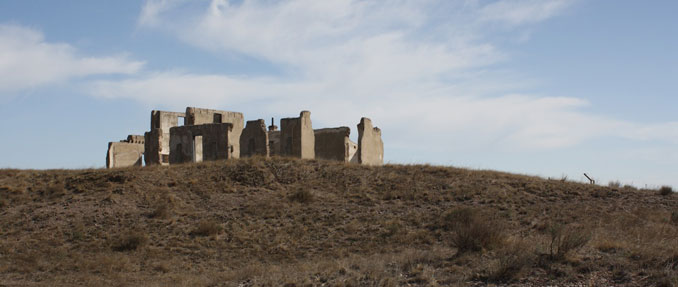
Resources
Primary Sources
- “Fort Laramie Treaty, 1868,” the full text of the treaty, in New Perspectives on the West, a website published by PBS, accessed April 12, 2013 at http://books.google.com/books/about/The_Fort_Laramie_Treaty_1868.html?id=MhDK9sgeSLcC.
- Maynadier, Col. Henry E. “Letter to Headquarters West Sub-District of Nebraska, March 9, 1866,” in Report to the Commissioner of Indian Affairs for the Year 1866. Washington: Government Printing Office, 1866, No. 86, pp. 207-208. Accessed April 12, 2013 at http://archive.org/stream/usindianaffairs66usdorich#page/206/mode/2up. This letter is Maynadier’s description of the funeral the day it happened.
- Johnson, Hervey. Tending the Talking Wire: A Buck Soldier’s View of Indian Country, 1863-1866. Edited by William E. Unrau. Salt Lake City: University of Utah Press, 1979, pp. 331-32, 342, 345. Johnson, an enlisted man in the 11th Ohio Cavalry, which served along the North Platte River in the mid 1860s, wrote about 100 letters home to his mother and sisters. He is frank in his opinions of his officers, including Maynadier.
Secondary Sources
- Clough, Wilson O. “Mini-Aku, Daughter of Spotted Tail.” Annals of Wyoming, vol. 39 No. 2, (1967), pp. 187-216, accessed April 12, 2013 at http://archive.org/stream/annalsofwyom39121967wyom#page/186/mode/2up. Clough gives Maynadier’s account of the funeral verbatim, quotes heavily from the account of the chaplain, Asa Wright, and goes on to do a thorough job sifting fact and likelihood from the many more romantic or misguided versions of the fascinating story of Spotted Tail’s daughter. He also works carefully to figure out what the young woman’s real name was, and comes to a conclusion nearly identical with modern Sicangu (Brulé) Lakota tradition.
- Flannery, L.G. (Pat). “A Backward Looking Prelude: Ahho-appa, Daughter of Shan-tag-alisk (The Legend of Fallen Leaf).” John Hunton’s Diary, vol. 4. Lingle, Wyoming: The Guide-Review, 1963, pp. 15-25. Hunton was a trader at Fort Laramie beginning in 1873, and kept a terse diary for decades. Flannery knew Hunton in the 1920s. This article is good example of how a small amount of information can get romantically expanded.
- “Fort Laramie Treaty Land.” Indian Ancestry, accessed April 12, 2013 at http://www.dickshovel.com/1868.html. A useful map of the reservation specified by the Treaty of 1868, together with the “unceded Indian territory” overlain with the boundaries of today’s reservations.
- Hafen, Leroy R. Fort Laramie and the Pageant of the West. Glendale, California: Arthur H. Clark Co., 1938, pp. 341-345. Good maps of the Fort are on pp. 308 and 376.
- Hyde, George E. Spotted Tail’s Folk: A History of the Brulé Sioux. Norman: University of Oklahoma Press, 1961.
- Larson, T.A., History of Wyoming. Lincoln: University of Nebraska Press, 1965, 21-35.
- Olson, James C. Red Cloud and the Sioux Problem. Lincoln: University of Nebraska Press, 1965, 12-95.
- Nadeau, Remi. Fort Laramie and the Sioux. Lincoln: University of Nebraska Press, 1967, pp. 201-205.
- National Park Service. “Peace Talk and War on the Bozeman Trail, 1866-1868.” Fort Laramie National Historic Site. Accessed April 12, 2013 at http://www.cr.nps.gov/history/online_books/hh/20/hh20m.htm.
- Smith, Jean Edward. Grant. New York: Simon and Schuster, 2001, 434-435; 516-541. A good book for the interplay between the politics of Reconstruction and the Indian wars.
- Theobald, Mary Miley. “The Story,” in Honoring Maynadier & Spotted Tail, accessed April 12, 2013 at http://maynadierspottedtail.wordpress.com/the-story/.
For Further Reading
- “Coda Chiazzata (Spotted Tail).” Farwest.It, accessed April 12, 2013 at http://www.farwest.it/?p=83, a biography of Spotted Tail in Italian, which includes an account of Mni Akuwin’s funeral, “un elborato funerale,” on a website for Italians who love the American West.
- Honoring Maynadier and Spotted Tail, accessed April 12, 2013 at http://maynadierspottedtail.wordpress.com/. This website is maintained jointly by descendants of Maynadier and Spotted Tail, and gives the young woman’s name as I have used it in this article.
- “Report to the President from the Indian Peace Commission, January 7, 1868,” accessed April 12, 2013 at http://facweb.furman.edu/~benson/docs/peace.htm. This is the peace commission’s report after it had concluded a treaty with the southern tribes but before making any headway with the Lakota. The document includes remarkable statements, such as this, about the fighting in 1865: “The result of the year's campaign satisfied all reasonable men that war with Indians was useless and expensive. Fifteen or twenty Indians had been killed, at an expense of more than a million dollars apiece, while hundreds of our soldiers had lost their lives, many of our border settlers had been butchered, and much property destroyed. To those who reflected on the subject, knowing the facts, the war was something more than useless and expensive; it was dishonorable to the nation, and disgraceful to those who had originated it.”
- Viegas, Jennifer. The Fort Laramie Treaty, 1868: A Primary Source Examination of the Treaty That Established a Sioux Reservation in the Black Hills of Dakota. New York: The Rosen Publishing Group, Inc., 2006, accessed April 12, 2013 at http://books.google.com/books/about/The_Fort_Laramie_Treaty_1868.html?id=MhDK9sgeSLcC. An excellent introduction to the subject for students, with illustrations, maps, background, and a point-by-point examination of the treaty itself.
Illustrations
- The 1863 sketch of Fort Laramie is from the collections of the American Heritage Center at the University of Wyoming. Used with permission and thanks.
- The photo of Spotted Tail about 1880 is by David Francis Berry, from the Library of Congress via Wikipedia. Used with thanks.
- The photo of Col. Henry Maynadier is from generalsandbrevets.com, a handy site for photos of Civil War generals and brevet generals. Used with thanks.
- The 1881 photo of Mni Akuwin’s grave is from the Wyoming State Archives, via the National Park Service. Used with thanks.
- The 1891 photo of Red Cloud is from firstpeople.us, a site packed with thousands of early photos of North American Indian people. Used with thanks.
- The photo of Man Afraid of his Horses smoking a ceremonial pipe at the Fort Laramie treaty negotiations in 1868 is image MS 4605 (01601208) from the National Anthropological Archives at the Smithsonian Institution. Used with permission and thanks.
